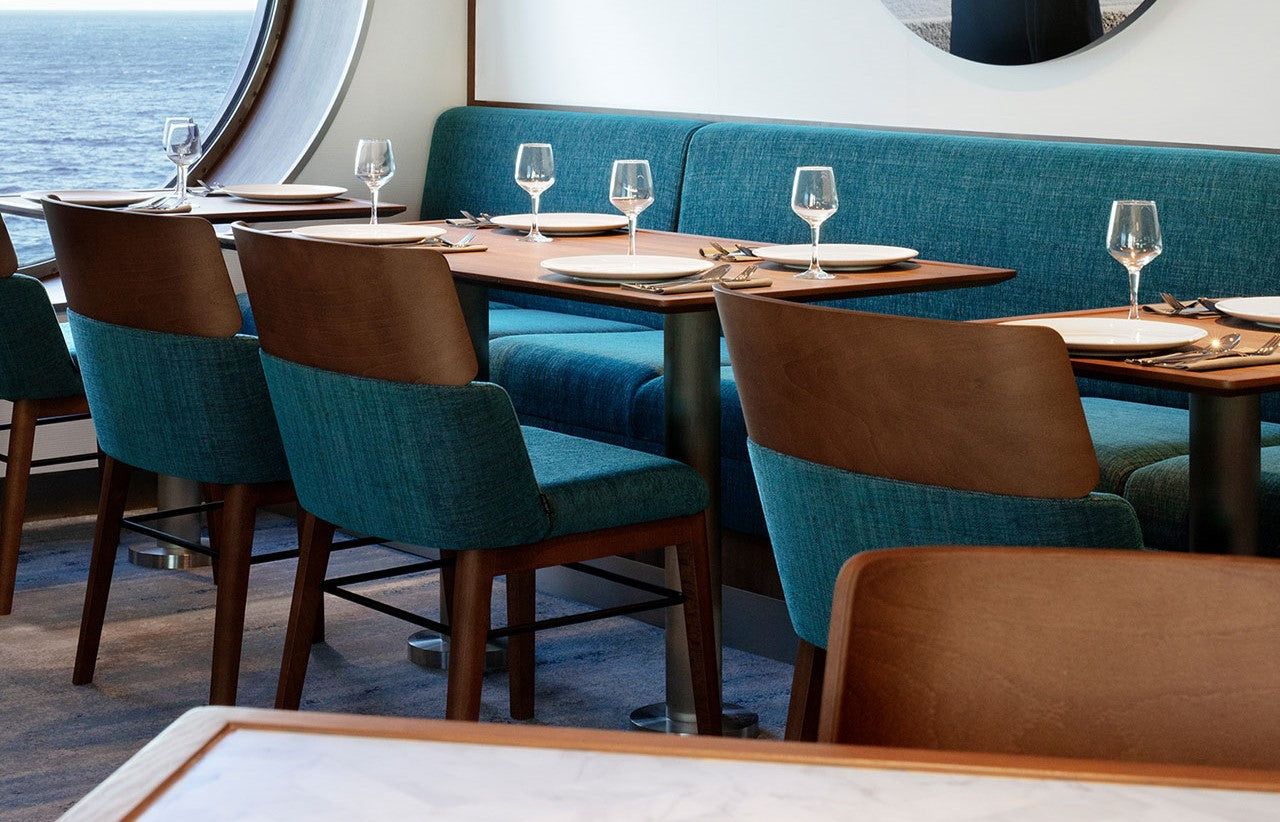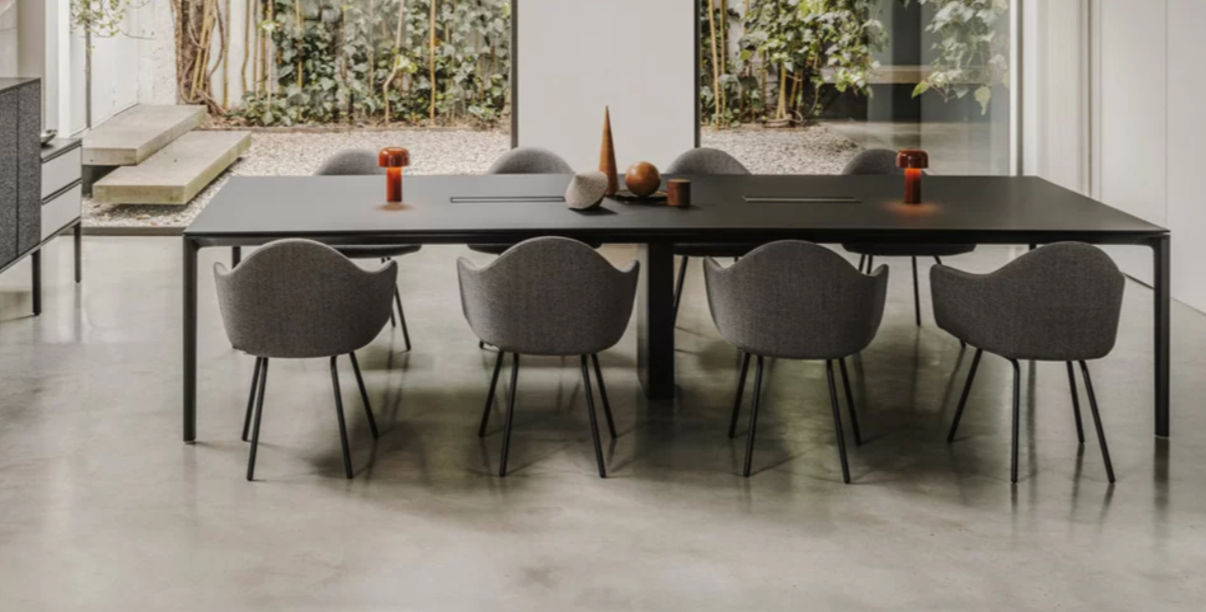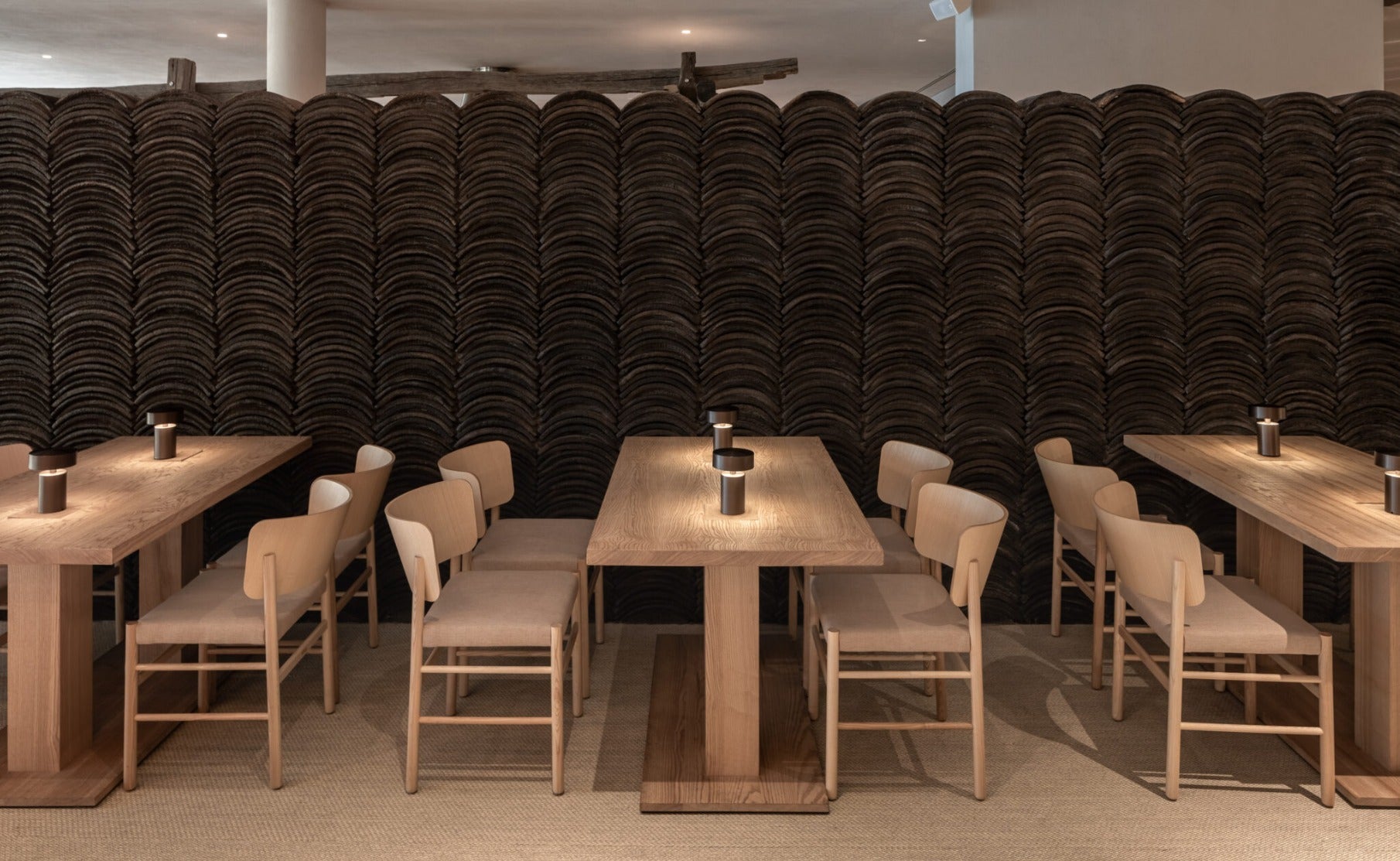
What is Performance Fabric? And Why We Think It’s the Smart Choice for Upholstered Chairs
Modern interiors are made for real life. They’re crafted to host candlelit dinners, handle the occasional red wine mishap, and adapt seamlessly as their owners’ lives evolve. Nowhere is this balance between aesthetics and practicality more essential than in the dining room.
As dining chairs become more sculptural and upholstery choices more refined, designers are choosing materials that promise durability without sacrificing visual appeal. Among these, one textile has quietly become a trusted favourite: performance fabric.
Once seen as purely practical, it’s now among the most sought-after upholstery options for both homes and hospitality settings. The reason is clear – it allows upholstered dining chairs to maintain their refined presence even in spaces where daily use is non-negotiable and the occasional imperfection is simply part of life.

What is performance fabric in kitchen & dining furniture, according to interior experts?
Performance fabric refers to a category of textiles engineered to resist common sources of wear: stains, spills, UV fading, and moisture. Unlike traditional upholstery, which often absorbs what it encounters, performance fabric is made to withstand it.
Interior designers and specifiers have embraced these materials for modern dining chairs not just for their resilience, but for their creative freedom. Where clients once had to choose between visual appeal and practical durability, performance fabrics now allow them to have both. Lighter colors, richer textures, and sculptural silhouettes are all back on the table.
What sets these materials apart is the way they’re engineered. The protective qualities are built into the structure of the fabric itself rather than added as a surface treatment, which means their benefits don’t diminish with use.
What Makes Modern Dining Room Chairs with Performance Fabric Different from Regular Fabric?
Modern dining chairs serve a visual and functional purpose. They define the aesthetic tone of the dining space while supporting everyday use - from weeknight meals to long dinner parties. But the difference between chairs upholstered in performance fabric and those in standard textiles comes down to more than just maintenance. It’s about longevity, ease of care, and the ability to design without hesitation.
While traditional fabrics like cotton, linen, or wool blends may offer softness and natural texture, they typically absorb moisture, stain easily, and fade with exposure to sunlight. Performance fabric is engineered to eliminate those vulnerabilities without compromising appearance or tactile quality. However, as per Penny Morrison
“Strong and hard-wearing fabrics needn’t feel particularly strong or hard-wearing”
What sets apart performance fabric designer chairs from the others?
-
High abrasion resistance
Designed for high-traffic areas, these textiles can withstand daily use without pilling, tearing, or showing signs of fatigue. -
Water and oil repellency at the fiber level
Liquids bead on the surface instead of soaking in, making cleanup faster and preventing long-term staining. -
Colorfastness under direct sunlight
Unlike standard upholstery, designer chairs made out of performance fabric retain their color even in bright, naturally lit spaces. -
Easy spot cleaning with mild soap and water
No need for chemical cleaners or professional services. Most spills can be resolved with minimal effort. -
Available in designer-grade weaves, velvets, and textural blends
Modern textile innovations mean you no longer have to sacrifice look or feel for durability. From tailored neutrals to dramatic textures, performance fabrics offer elevated options.

The result is furniture that holds its visual integrity over time, regardless of how often it’s used. Whether specified for upholstered dining chairs in a private residence or contract quality chairs in a hospitality setting, performance fabrics provide unmatched flexibility for the way we live and entertain today.
In recent years, some of the most respected names in textiles have elevated the category with sophisticated collections that look and feel anything but utilitarian.
-
Kvadrat, known for its clean, architectural palettes and contemporary textiles,
-
Dedar, celebrated for its bold and tactile Italian sensibility, and
-
Perennials and Sunbrella, both leaders in fade-resistant, soft-touch fibers, have redefined what performance truly looks like in a luxury context.
Here's why Performance Fabric for Upholstered Chairs Doesn’t Just Look Clean, It Stays Clean
The modern dining space demands more from materials than ever before. It’s where guests linger, meals happen daily, and furniture is used more frequently than nearly any other piece in the home. In these high-traffic zones, performance fabric proves its value not by appearing flawless in the showroom, but by maintaining its condition years into use.
What makes it truly different from conventional fabrics isn’t just stain resistance. It’s how the resistance works at a microscopic level and why it holds up to real-world conditions long after standard materials begin to show wear.
The Science Behind Cleanability of Performance Textiles: Hydrophobic and Oleophobic Technologies
At the fiber level, performance textiles are engineered to create an inhospitable environment for stains and moisture. This protection is not sprayed on or applied after weaving, it’s embedded in the construction of the fabric itself.
There are two key protective mechanisms at work:
-
Hydrophobic fibers repel water-based liquids like wine, coffee, or juice. Instead of absorbing into the weave, the liquid stays on the surface, making cleanup fast and straightforward.
-
Oleophobic fibers resist oil-based substances - think salad dressing, skin oils, or cosmetics. These are the types of stains that typically absorb deep into untreated fabric, leaving behind long-term discoloration.
Together, these technologies create a fabric that doesn't simply delay staining, but actively prevents it.
Unlike traditional upholstery, which can hold onto residue even after cleaning, performance fabric ensures that spills do not penetrate or leave a lasting impact. This is particularly important in dining chairs, where food-related stains are not the exception but the expectation.
In performance testing for contract interiors, fabrics with hydrophobic and oleophobic treatments consistently maintained their structure and color after 30,000 rub cycles and dozens of spot cleanings.
Why Performance Fabric is Ideal for Dining Environments
Dining chairs occupy a unique role in the home or hospitality setting. They’re used frequently, touched often, and expected to look tailored and inviting at all times. Performance fabric makes this possible by combining practicality with design integrity.
Where traditional upholstery limits your choices, discouraging lighter tones, textured finishes, or sculptural silhouettes, performance fabrics open them back up. Designers no longer need to make compromises between form and function.
Here's why designers consistently prefer performance fabric for modern dining room and restaurant chairs:
-
It allows for light-colored and textured upholstery without the risk of permanent staining
-
It extends the visual and structural life of the furniture
-
It reduces maintenance requirements for homeowners, restaurateurs, and staff
-
It supports continuity of design across open-plan kitchens, dining rooms, and lounges
Performance fabric doesn’t just perform under pressure, it elevates the entire experience of using, maintaining, and enjoying a well-designed dining space.
Explore kitchen & dining furniture that brings long-term beauty and functionality into balance.
Q&A: People Also Ask
What are the benefits of performance fabrics?
Performance fabrics offer long-term resistance to staining, fading, moisture, and abrasion. They also support a broader range of design choices by eliminating the need to compromise for the sake of practicality.
What is the difference between cotton and performance fabric?
Cotton is a natural, breathable textile, but it lacks built-in protection against spills or wear. Performance fabrics are engineered with durable fibers that resist liquids and stains, making them far better suited to high-use furniture like dining and restaurant chairs.
Is performance fabric good for dogs?
Yes. Performance fabric is durable enough to resist pet-related wear such as hair, drool, and minor accidents. It’s also easier to clean, making it an excellent option for pet-friendly homes.
Is performance fabric the same as microfiber?
Not necessarily. While some performance fabrics are microfiber, not all microfiber meets the durability, stain resistance, and colorfastness standards of performance-grade textiles. Performance fabrics refer more broadly to any upholstery designed to withstand demanding environments.
Conclusion
Performance fabrics have shifted the way designers approach high-use spaces. They offer creative flexibility, extend the lifespan of upholstered furniture, and align with the expectations of clients who need contract grade furniture that provides lasting beauty without the upkeep.
In dining areas, where spills are common and furniture is touched and used daily, performance fabric offers peace of mind without sacrificing design integrity. It is, simply put, a smarter way to furnish.
Want to explore more? You May Also Like
Choosing the Right Fabrics For Your Modern Dining Chairs
A practical guide to understanding fabric durability, care, and texture when selecting dining chairs - ideal for those furnishing high-use spaces without compromising on design.
Mastering Fabrics and Finishes: A Guide to Texture in Luxury Dining Chairs
An exploration of tactile design, this post dives into how texture enhances dining spaces - from soft matte finishes to rich woven fabrics that create depth and warmth.





